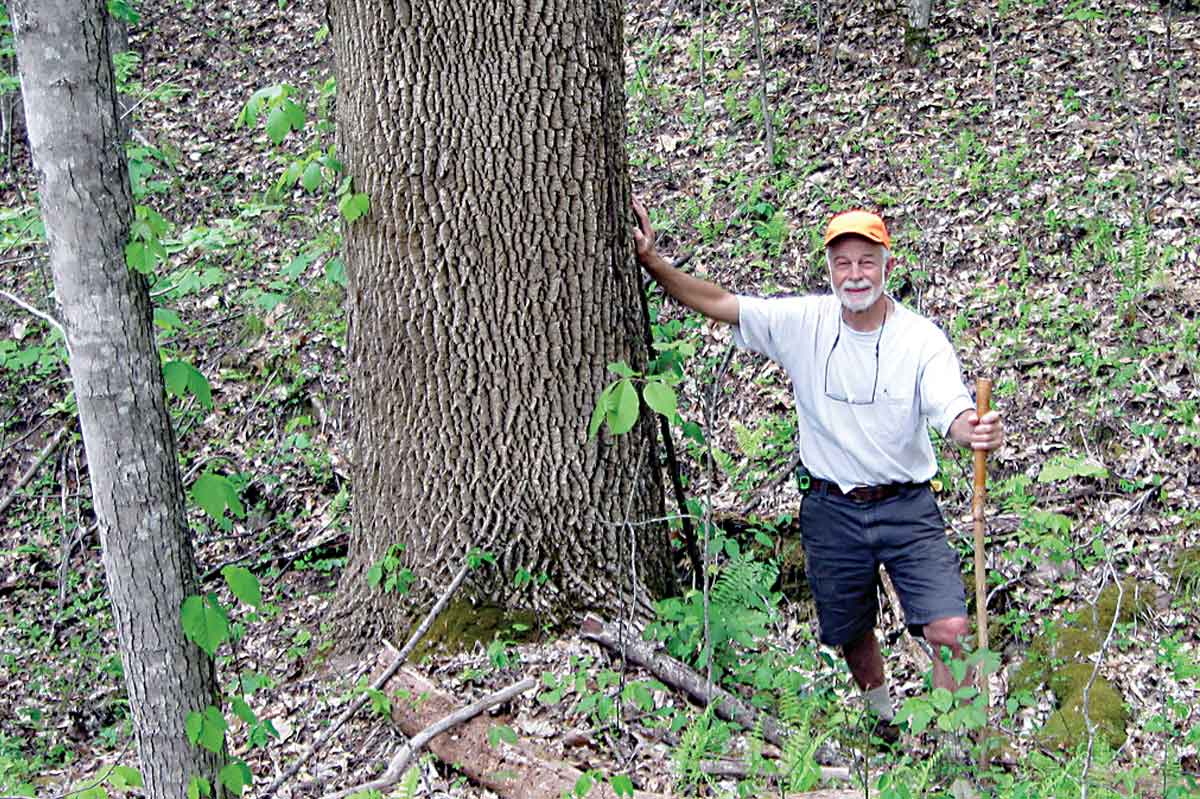Up Moses Creek: Moses Creek goes global
 Burt Kornegay stands beside the big white ash the year before invasive emerald ash borers killed it. Becky Kornegay photo
Burt Kornegay stands beside the big white ash the year before invasive emerald ash borers killed it. Becky Kornegay photo
To my eyes it was as magnificent a tree as could be found in Western North Carolina — an eastern hemlock near Dismal Falls, on the flank of Big Pisgah Mountain.
Every bit of 5 feet thick and 150 feet tall, probably rooted there before 1492, the hemlock had dark, deeply furrowed bark protecting a trunk that rose higher than nearby trees into clear air, where its deep-green needles, gathered in a conical crown, took in the sun. Dismal Creek flowed past, its downhill rush contrasting with the tree’s still, upward, enduring stance on the mountain. When I used to lead backpacking trips in Panthertown and took side hikes there, the tree was as much the destination as the waterfall itself.
Until the year it became painful to see. An insect called the hemlock wooly adelgid, accidentally introduced into the United States from Asia, was spreading through the mountains in the 1990s, and like loggers of old, it went for the biggest, most mature trees first. The insect was smaller than a pinhead, but that year a million pinheads pierced the needles of the great tree and sucked the life out of it. The crown thinned, turned dull grey. By 2000 what greeted my eyes was a giant snag.
The insect was the immediate cause of the tree’s death, and the death of tens of thousands of other hemlocks. But there was a deeper, underlying cause: globalization, the commercial movement of goods from every part of the world to every other part, and especially to our part, bringing not only the stuff for which Americans shop till they drop, but foreign pests and blights. That hemlock’s death, for me, was the herald of globalization.
Waves of infestations have washed on these mountain shores since Becky and I moved here nearly 40 years ago. We watched the Balsam wooly adelgid, from Europe, turn the firs that crowned the Great Smokies into skeletal “ghost forests.” We watched dogwood anthracnose kill flowering dogwoods along the trails we hiked. Eight years ago, weird little candy-cane shaped tubes of sawdust began to emerge ominously from the trunks of two healthy sassafras trees growing near our house—a sure sign, I learned with sadness, of the invasive red bay ambrosia beetle boring its way within. The beetle lays its eggs in plants of the laurel family, which includes sassafras, and, along with a wilting fungus it carries, it killed both our trees by summer’s end.
In 2019, a stone’s throw from where the sassafras had been, I noticed the largest white ash tree on our land was losing its leaves. The next summer the bare branches turned a strange, blotchy, yellow color. I discovered that the blotches were places where the tree’s handsomely patterned bark was being stripped back by woodpeckers that were going after the larvae of the Asian emerald ash borers, eating their way through the tree’s cambium.
Related Items
Now, four years later, every one of our large ash trees is dead. I’m a canoeist, and my favorite paddle is carved out of white ash. My canoe’s gunwales, thwarts, and seats are made of that tree’s beautiful straight-grained wood. The tree’s seeds look like miniature canoe paddles. Because we heat with wood, I have felled and bucked up some of the dead ashes. The wood splits with a single pop of the maul. Ash makes for a hot fire on a cold day; but give me back the living ash tree, not woodstove ash.
What other pests have “globalized” Moses Creek? Every fall, two days after the first hard frost, Asian lady beetles begin to work their way into our house for the winter. Preceding them by a month, marmorated stinkbugs by the hundreds buzz in like tiny drones and latch onto our windows, doors and walls. It seems like just yesterday that I saw the telltale mounds of fire ants newly arrived at the mouth of Moses Creek. Moving faster than the ants, Japanese stiltgrass has begun to choke out the native wildflowers.
It was just yesterday — Sept. 18, to be exact — that a friend sent me a picture of a brand-new animal on his Cullowhee Creek land: the Joro spider, from Asia. The spider had stretched a web across Fred’s trail, its tough strands needed to support the spider’s black and yellow body and 4inch leg span.
As for tomorrow? Rest assured that whatever creek you live up, the gypsy moth and the spotted lantern fly are coming to a tree near you.
It is not cheap clothes from Bangladesh, ipe wood from Brazil, coffee from Sumatra, cars from Mexico, more products from China than you can shake a stick at, but the accompanying pests and diseases that wreck our native plants and animals — this is what globalization means up Moses Creek.
(Burt Kornegay ran Slickrock Expeditions in Cullowhee for 30 years, and he is the author of “A Guide’s Guide to Panthertown Valley.” He lives with his wife Becky up Moses Creek in Jackson County.)









